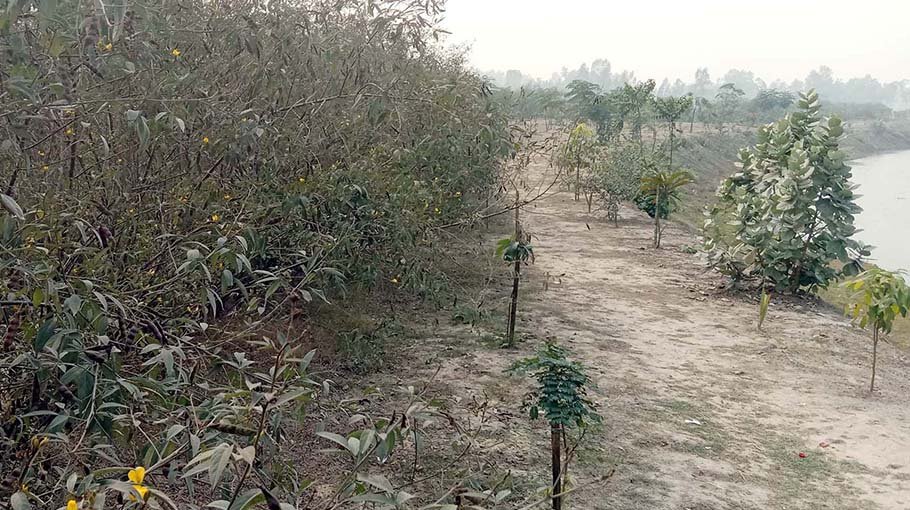Pigeon pea farming likely to change agro scene in Rangpur


Pigeon pea, also known locally as ‘Arhar’ is a good cash crop. This is because the demand for pigeon pea pulses is as good as the price of this crop in the market remains good all year round. Pigeon pea is also considered as a high quality medicinal plant. In addition, barren lands are sufficient for cultivating this crop. This crop can even be produced only by planting rows in the aisle of the land.
The Barind Multipurpose Development Authority (BMDA) has taken initiative to expand the cultivation of pigeon pea in the north by showing it as a model. They have erected fences on all four sides of their dug canals. In addition to beautification in nature, there is also mass production, the farmers are being inspired. The concerned authorities have taken the responsibility of supplying the seeds.
It is known that pigeon pea is a type of perennial herb. The leaves are somewhat elongated and the head is eye-shaped. The flowers are yellow, the seeds are small round. The fruit is like a small shoot, but is slightly flattened. It grows on any land. Around 44.9 lakh tonnes of pigeon pea pulses are produced worldwide. About 63% of this production is produced in India. Although pigeon pea is cultivated in Rangpur, Dinajpur, Kushtia and Jashore districts of Bangladesh, it is not very common. Pigeon pea seeds ripen in February-March. The seeds are sown in April-May before the monsoon.
Pigeon pea is a leguminous family of legumes and has many uses and benefits. It also has many medicinal properties. Leaves and its juice are used for cough, jaundice, anorexia, sore throat, hemorrhoids, hemoptysis. In the early stages of jaundice, it is beneficial to drink the juice of pigeon pea leaves warmly. Pigeon pea leaf juice is also effective in controlling diabetes. Regular consumption of pigeon pea leaf juice is beneficial to prevent burns on hands and feet and to increase appetite or to get rid of old cough.
Farmers in the north usually cultivate pigeon pea on land aisles or on the banks of canals and ponds as a fence for other crops. It protects other crops from cows and goats, as well as a large yield of pigeon pea.
Farmers said that it can be harvested within 120 days of planting this crop. In the case of short-term varieties, the distance between rows and trees will be one foot, in medium-term varieties two feet and in long-term varieties seeds may be sown at a distance of three feet / two feet. It goes without saying that there is no one-time cost for its cultivation, nor is there any need for fertile land. If only the cost of seeds is given, pigeon pea can be cultivated as an additional crop in the land aisle. Three to three and a half kg of seeds are required per bigha. However, due to the increase in the cultivation of new high yielding new crops, the medicinal and potential stalk crop pigeon pea has been lost today. Authoritiesalso said that the farmers should be made aware about this.
According to the Rangpur Regional Office of the Department of Agricultural Extension, the target for pigeon pea cultivation in the Rangpur region this year has been set at 60 hectares, but only 36 hectares have been achieved. These include 30 hectares in Rangpur district, 5 hectares in Gaibandha and 1 hectare in Lalmonirhat. Mentioning that the cultivation of pigeon pea is profitable for various reasons, the source said that the cultivation of pigeon pea in a barren land is also suitable for other reasons. If it is cultivated at low cost, the leaves of the tree will fall on the ground and the tree will also become a fertilizer for the land. In this way, barren land will gradually become suitable for cultivation of other crops. As pulses are a national crop, it helps in increasing soil fertility. Atmospheric nitrogen is stored in the roots of pigeon pea, which in turn enhances the fertility of the soil and helps in preventing soil erosion. In addition, if the tree is a little bigger, it also matches the fuel. The pigeon pea tree acts as a shelter for the beneficial insects of the crop. As a result, the amount of profit of the farmers will increase even if only a little.
The Barind Multipurpose Development Authority (BMDA) has dug up the illegally occupied Bharardaha Beel at Badarganj in Rangpur district. The Beel, which was excavated last year under the Irrigation Extension Project in the greater Rangpur district through optimal use of surface water and conservation of rainwater, reclaimed the lost 12-acre Beel. Going to Bharardaha Beel on the spot, it can be seen that on the bank of the Beel is about 100 feet wide, pigeon pea crops have been planted all around. The shoots of pigeon pea are swaying in the trees. Shoots are being collected for seeds.
In this regard, Habibur Rahman Khan, Director and Supervising Engineer, EIRP Project, Barind Multipurpose Development Authority, said, On the one hand, the safety of the canal is being ensured by the fence of pigeon pea tree, on the other hand, decoration is also being done. On the other hand, pigeon pea is also giving yield again. Seeing all this, the people who have come to the banks of the Beel including the local farmers are being inspired to cultivate pigeon pea.


